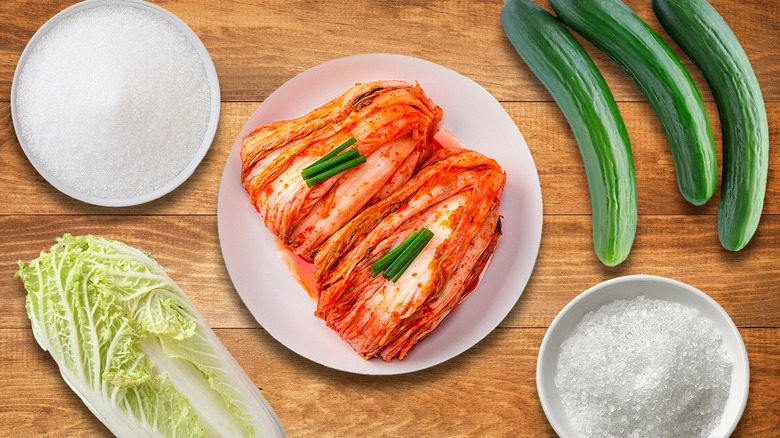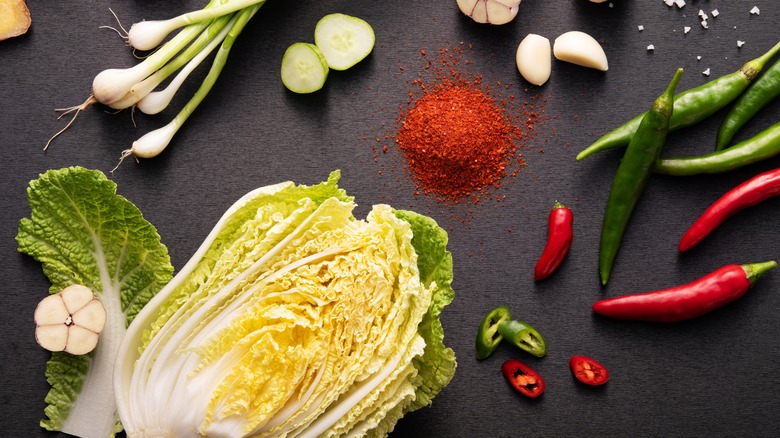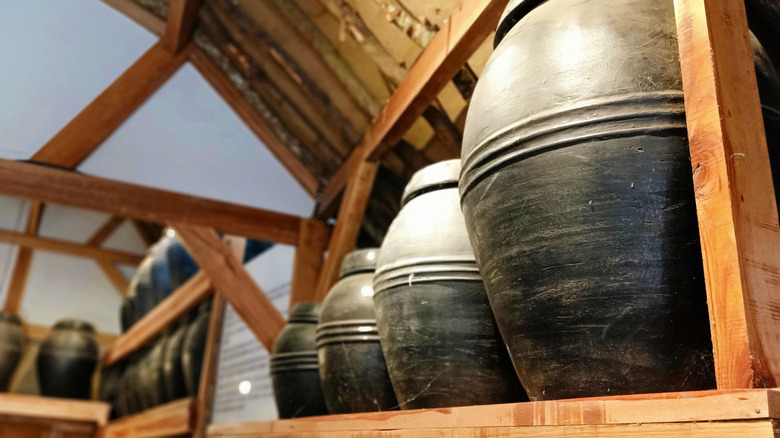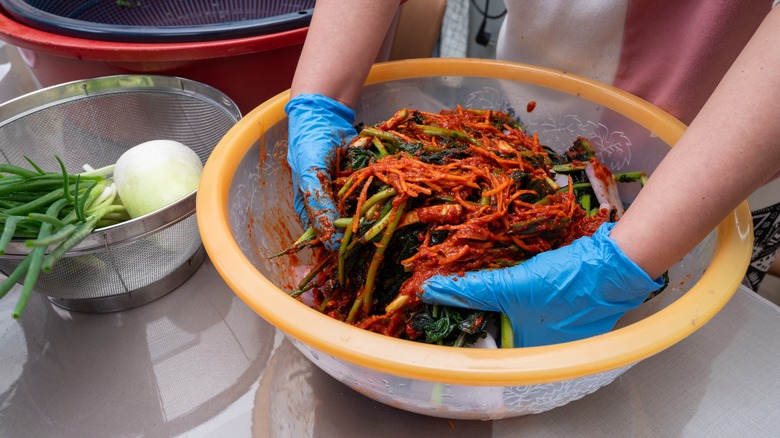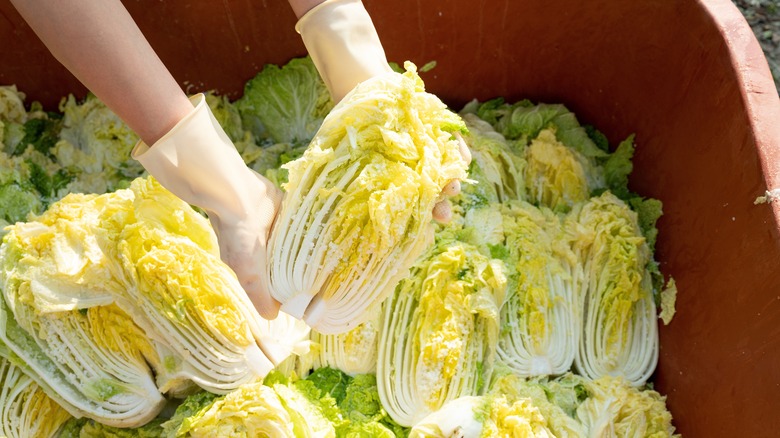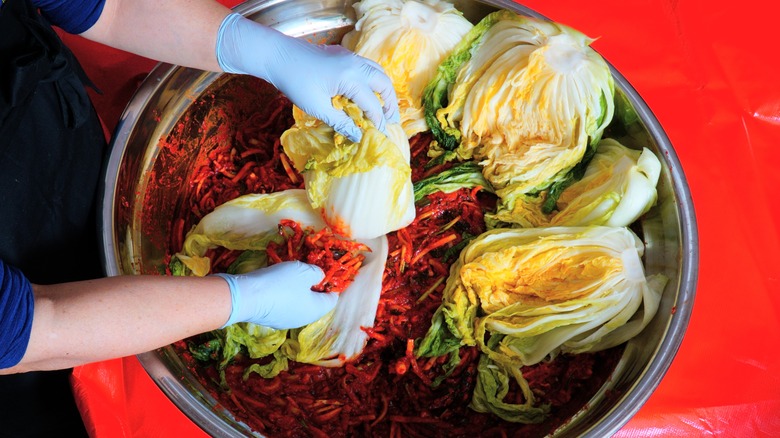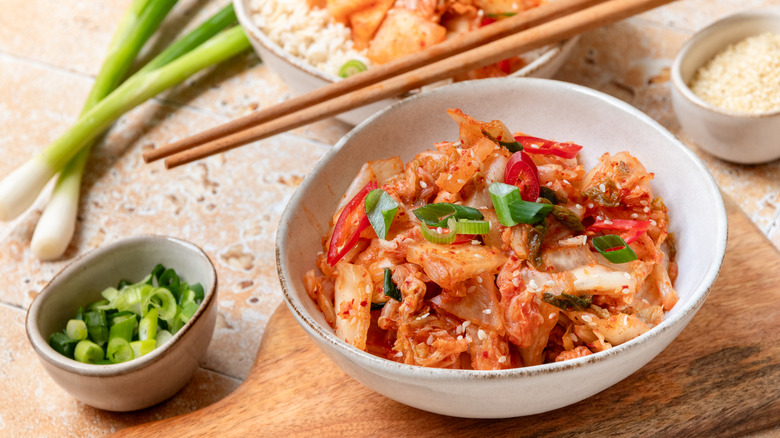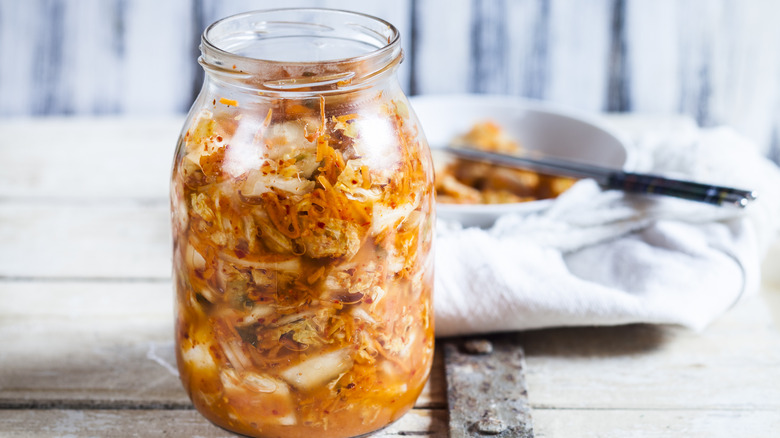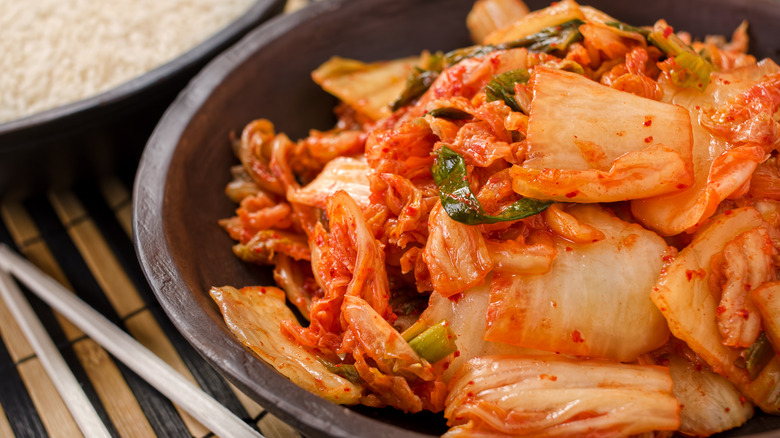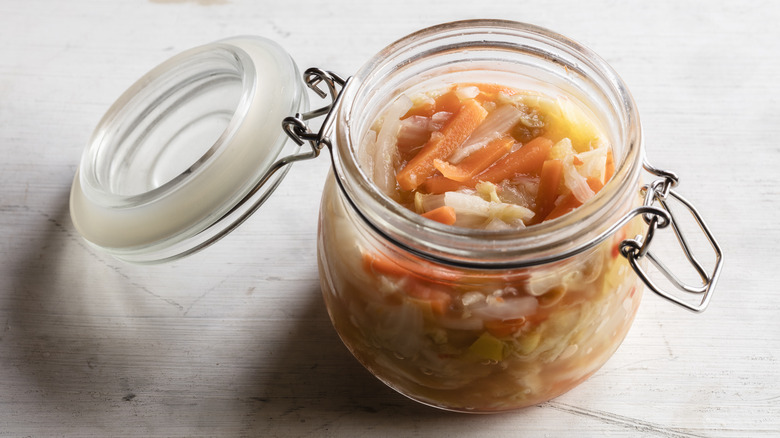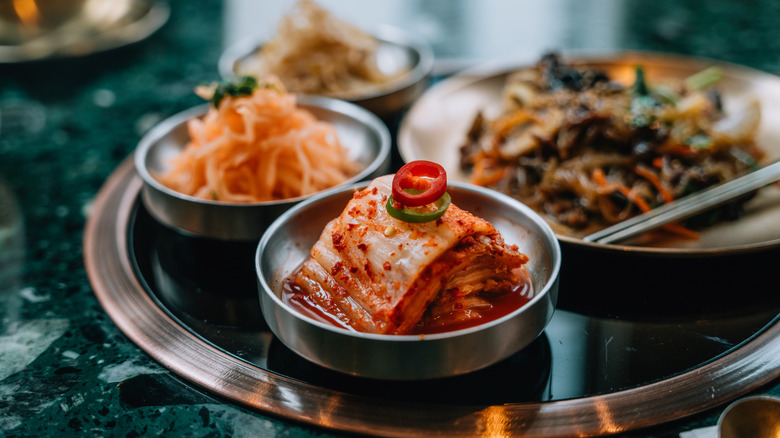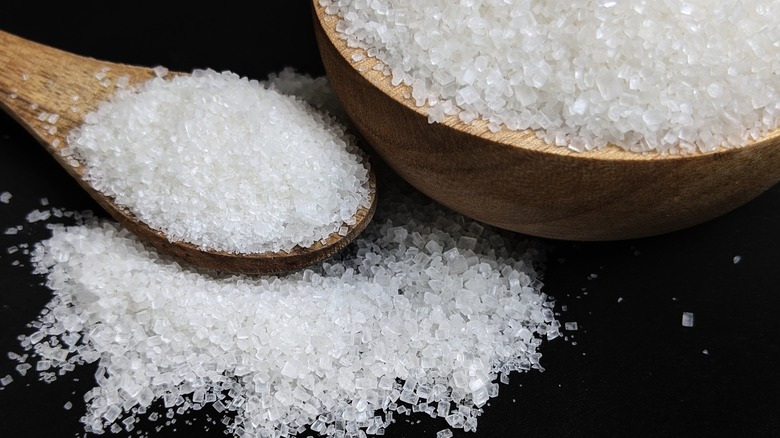11 Mistakes To Avoid That Will Ruin Your Homemade Kimchi
Korean food is beloved for its bold, punchy flavors, and no Korean meal could be considered complete without some form of kimchi. The term simply refers to salted, fermented vegetables, therefore kimchi can be prepared in a wide range of ways. Everything from mild and refreshing dongchimi, a brothy radish preparation, to pickled perilla leaves. The type of kimchi most familiar to American diners is a tangy, garlicky concoction of fermented cabbage with a bright red hue from a long soak in chili paste. Not only are its crunch, tartness, and spice a perfect foil for the rich meat and sweet glazes of Korean barbecue, but its naturally occurring probiotics are good for us too. And cooks have discovered it's not only great with traditional Korean meals, but as a tasty add-in to instant ramen and a flavor multiplier in Western dishes such as warm cheese dip.
But the Korean cooks who first made kimchi weren't worried about their gut biome. Historically, they developed it as a means of preserving produce for their long winters, and communities would gather together each fall for giant kimchi-making parties, in which they'd prepare enough kimchi to keep everyone nourished until spring. And now that the rest of the world has discovered its delights, cooks of all backgrounds now make their own kimchi — and you can too. Here to offer their expert tips are Kheedim Oh, Chief Minister of Kimchi for Mama O's Premium Kimchi, and Jaehong Park, R&D chef at Bonchon International.
Be careful when choosing your veggies
No matter what kind of kimchi you choose to make, the quality of your vegetables matters. A big mistake is choosing substandard produce, thinking the fermentation process will cover up its flaws. "When selecting vegetables for kimchi, freshness is key," Jaehong Park said. "Look for vibrant, firm vegetables without any blemishes or bruises. For napa cabbage [the central ingredient in the commonly found cabbage kimchi], choose heads that feel heavy for their size with crisp, tightly packed leaves. Avoid wilted or overly soft vegetables as they may not ferment properly and can impact the texture and taste of the kimchi."
And while cooks make kimchi with a wide range of vegetables, from cucumbers to radishes to cabbage and more, some types of veggies simply work better for kimchi than others. Remember that the fermentation process tends to soften vegetables, so starting with already soft or delicate produce may yield soggy results. "You want to look for vegetables in good shape that have some fiber," Kheedim Oh said. "Something that will help it hold up over time."
You don't need an earthenware vessel
If you've researched traditional kimchi recipes and production methods, you may have encountered videos of experienced Korean cooks deftly preparing their vegetables and their seasonings, and then packing them into large earthenware pots to ferment. In cold climates, cooks would bury these pots underground to keep their contents from freezing.
This may lead you to think you need such a pot to make the best and most authentic kimchi. But the experts assure us there's no need for that, and modern alternatives can work just as well. "A ceramic or glass fermenting vessel is ideal for home cooks, as these materials are non-reactive and maintain consistent temperatures," Jaehong Park said. "Traditional Korean earthenware [called] onggi (fermenting crocks) are excellent but not always accessible." Kheedim Oh adds that if you do choose to seek out a traditional pot, proceed with caution." We do not recommend fermenting in earthenware vessels or anything with lead ... the acid may leach out the lead in it," he said.
Make sure your equipment is clean
For home cooks brought up to value kitchen cleanliness above all, the fermentation process involved in kimchi production may seem counterintuitive. You're literally inviting foodborne micro-organisms to settle and proliferate, a process that ultimately preserves the kimchi and gives it its distinctive flavor. It's an ancient and proven preservation method and perfectly safe when done correctly, which means making your kimchi in a way that nurtures wanted microorganisms while keeping bad ones at bay. And this means starting with clean equipment.
"Cleanliness is crucial," Jaehong Park said. "Wash all utensils and containers thoroughly with hot, soapy water and rinse well. For an extra layer of precaution, sanitize them with boiling water or a vinegar solution to eliminate any bacteria that might disrupt the fermentation process." Starting with a clean environment, Kheedim Oh explained, will also give beneficial micro-organisms a solid head start. "As long as you do that, the beneficial probiotics will thrive and crowd out any pathogens as your kimchi ferments."
Don't neglect the initial salting step
A big part of what makes kimchi so tasty is how the seasonings — which can include garlic, ground chilis, ginger, and briny add-ins such as fish sauce or dried shrimp — permeate every bit of the veggies, making each bite a satisfying flavor bomb. But to get all these flavors into your vegetables, you need to do more than just mix everything together. You need to ensure your vegetables are primed to absorb as much of the seasonings as possible.
This means that after you wash and cut your vegetables to size, you need to salt or brine them. As Jaehong Park explained, this initial salting process draws liquid from the veggies, which both crisps them and makes more room for flavorings to seep in. While some recipes call for immersing the veggies in brine, others ask cooks to rub salt into the vegetables instead. In either case, the salt stays on for only a few hours before being washed away — its purpose is to texturize the vegetables, not to flavor them.
Don't overdo the salt, either
The spicy cabbage kimchi most familiar to American diners is powerfully flavored and salty. And while a lot of salt goes into kimchi making, not all of it should end up in the finished product. So during the initial brining/salting stage, be mindful of how much salt you use. While too little can result in bland, underflavored kimchi, too much can wilt your vegetables and inhibit fermentation. Thus, follow your recipe closely and be sure to measure your salt accurately.
To keep your kimchi from becoming too salty, you should also be mindful not to let it sit with the salt or brine for too long — a few hours is usually enough. Once you've completed the initial salting stage, it's important to rinse your vegetables multiple times (some sources recommend three to four times) to remove as much salt as possible. After the rinse, be sure to give your vegetables time to drain thoroughly. This will not only ensure all excess salt is gone but also help it better absorb the seasonings later.
Expecting it to taste like kimchi right away is a mistake
Tasting as you go is always a good strategy for cooks. It not only helps you know if your dish is progressing in a way you like, but over time, it helps you understand how the flavors of different ingredients evolve as a recipe progresses. Thus, it's definitely a smart idea to taste the seasoning mix you plan to use in your kimchi. If you sense too much or too little of anything, you can adjust the mixture before adding it to your vegetables.
While doing this will give you a pretty good idea of part of your kimchi's flavor profile, you may notice something's missing: kimchi's signature tang and funk. This is because these flavors come not from the seasonings, but from the fermentation process, which means they won't emerge until after the kimchi has fully fermented. "One of the biggest problems is that people try and make the kimchi taste like what it is going to taste like after three weeks of fermentation," Kheedim Oh explained. "It's difficult to know what the kimchi should taste [like] first in order to taste like kimchi after it has fermented." If this problem sounds familiar to you, Oh recommends making kimchi with store-bought kimchi seasoning paste. "You can use it once and understand how your kimchi should taste before it is transformed on the molecular level," he said.
Don't forget to keep your kimchi submerged
Once you've salted, rinsed, and seasoned your kimchi vegetables, it's time for the most important stage: fermentation. Fortunately, this is a largely set-it-and-forget-it operation — it simply requires you to put your seasoned vegetables in the fermentation vessel, cover it, and wait. And you won't have to wait long. Unlike its close relative sauerkraut, which requires weeks to achieve its signature flavor, kimchi can turn pleasantly tangy in as little as one or two days if fermented at room temperature. (If you ferment it in the refrigerator, it will take a bit longer.)
While this time-tested fermentation method is perfectly safe when done properly, the fermentation stage also opens opportunities for contamination. Specifically, airborne microbes can potentially find their way into the fermenting vessel and cause your veggies to go bad. To prevent this, be mindful of how you fill your fermenting container. Be sure to pack your seasoned veggies tightly to push out any air bubbles that may form during filling. And to minimize air contact with the veggies at the top of the container, place a clean weight, such as a dish a bit smaller than the opening of the container, on top of the veggies to keep them submerged in the flavorful brine that will form as the mixture ferments.
Fermenting too long can make kimchi overly sour
Novice kimchi makers sometimes puzzle over why their creations don't achieve the flavor profiles they hoped for. Very often, homemade kimchi can turn out too sour or not sour enough. To control sourness, cooks first need to understand what causes it. "A lot of people think vinegar is added to kimchi," Kheedim Oh explained. "But the sourness comes from lactic acid. The lactic acid is a by-product of the probiotics digesting available sugar. Your kimchi will become progressively more sour over time."
Thus, too-sour kimchi results from an overly long fermentation period. To ensure you get the level of sourness you want, it's a good idea to taste your kimchi as it ferments. Once it tastes the way you want, you can slow down the fermentation by storing it in the coldest part of your refrigerator. However, Oh warns that you can't completely stop the process. "Fermentation cannot be stopped, only slowed down. Once it's too sour for your taste, there is no going back." Thankfully, Oh added, old, sour kimchi is still great for cooking. Not only does it add umami and depth, but the cooking process also mellows its acidity.
Overfilling your fermentation vessel can cause an explosion
One of the first things home cooks figure out is not to fill pots to the top before cooking, since doing so will inevitably lead to the pot boiling over as the food heats up and starts to bubble. A similar principle holds when making kimchi or any other fermented food; while it doesn't actually cook, it does still bubble. During fermentation, the beneficial microbes on the vegetables release carbon dioxide as they digest sugars in the kimchi mixture, and this gas is released in the form of bubbles floating up from the brine. So if you're not careful, you can end up with messy puddles of bubbled-over brine all over your kitchen counter or refrigerator shelves.
Thus, your fermentation vessel must be large enough to contain any potential splashes from the popping bubbles. Ideally, your kimchi mixture should fill it only about two-thirds of the way. If you're using a glass jar as a fermenting vessel, keep it covered, but not sealed too tightly — screw-on lids should be only lightly fastened to ensure gas can escape and avoid a messy explosion. To be on the safe side, you might want to place a plate under your fermenter to catch any potential overflow.
Fermenting at too high a temperature can cause problems
Natural fermentation processes, such as those involved in making kimchi or sourdough, are as much an art as a science. Each batch will be a bit different, depending on the weather and the health and makeup of the community of microbes responsible for the fermentation. Thus, cooks need to monitor each batch closely, adjusting whatever conditions they can to ensure the process goes as desired.
One variable cooks can control when making kimchi is the fermentation temperature. This is a critical factor since it determines how quickly your kimchi will ferment, and thus how its final flavor and texture will turn out. "Monitor the room temperature and fermentation time closely," Jaehong Park advised. "For a slower, less sour fermentation, refrigerate the kimchi sooner. For more tangy, well-fermented kimchi, let it ferment at room temperature for one to two days before refrigerating." Kheedim Oh agreed that room-temperature fermentation comes with risks. "If you leave kimchi out room temp, it will ferment faster but the vegetables will not be as crisp," he warned. Also, remember that room temperature for kimchi-making purposes is still fairly cool (around 68 degrees Fahrenheit), so if you live in a warm climate or are making kimchi during the summer, a refrigerator may be a better choice.
Beware of too much sugar in your kimchi
The range of possible flavors for kimchi is far wider than you may think. While American diners are familiar with the garlicky, chili-laden variety found in Stateside restaurants and even mainstream supermarkets, these flavors are not defining features of the dish. As Kheedim Oh explained, when it comes to flavorings for kimchi, the sky's the limit, and the best seasoning mix "is 100% subjective." He said, "I would typically say use lots of garlic, but some of the best kimchi I have ever had was from a monastery in Korea and they used no garlic at all!"
Among the ingredients that sometimes appear in kimchi recipes is sugar. It's not there to add sweetness, instead, it provides food for the beneficial microbes and thus helps promote fermentation. (Recipes for cabbage kimchi also often contain a slurry of rice flour, which is there for the same reason.) But while it can be helpful, too much sugar can promote the growth of unwelcome microbes. These often manifest as a slimy texture to your kimchi. While the flavor and safety of the kimchi are unaffected, the texture can be off-putting, so be sure you've measured your sugar properly before adding it.
